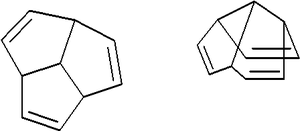Polyquinane
A polyquinane or polyquinene is a saturated or unsaturated, respectively, polycyclic hydrocarbon consisting of fused five-membered rings.[1] The simplest member is the bicyclic compound bicyclo[3.3.0]octane. Other members are triquinacene and dodecahedrane.
Triquinacene

The compound triquinacene (tricyclo[5.2.1.-04,10]deca-2,5,8-triene) is the second member of a family of polyquinenes. It was synthesized in 1964 in the group of R. B. Woodward[2] in connection with its suspected homoaromatic properties (although it was found to have no such properties), and also as part of a failed attempt to synthesize the then-elusive and much-coveted compound dodecahedrane. Unlike the related pentacene, triquinacene is stable, and has a melting point of 18°C. The final step of its synthesis is a Cope elimination.
See also
- Fused 6 membered rings: the acenes
- Triquinacene is isomeric with: bullvalene, diisopropenyldiacetylene
References
- ↑ Gold Book definition Link
- ↑ R. B. Woodward, T. Fukunaga, R. C. Kelly J. Am. Chem. Soc. (1964). "Triquinacene". Journal of the American Chemical Society. 86 (15): 3162–3164. doi:10.1021/ja01069a046.
